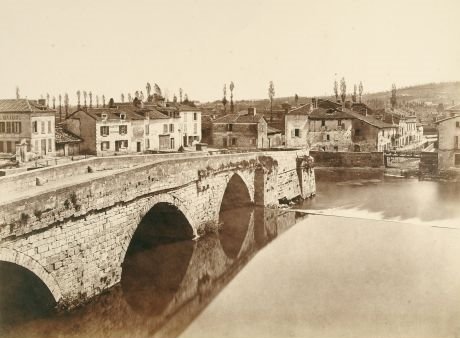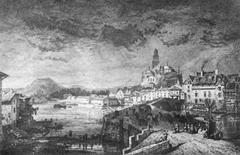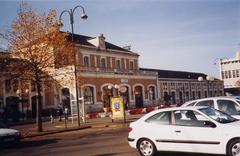
Comprehensive Guide to Visiting Pont des Barris, Périgueux, France
Date: 25/07/2024
Introduction
Nestled in the charming city of Périgueux, France, the Pont des Barris, also known as the Pont Neuf, stands as a remarkable testament to medieval engineering and architectural prowess. This historical bridge, which dates back to the 12th and 14th centuries, has been a vital part of Périgueux’s urban landscape, connecting different parts of the city and playing a significant role in its historical and cultural development. The bridge, originally called the Pont de Tournepiche, has undergone numerous reconstructions and restorations, reflecting the evolving architectural styles and engineering techniques over the centuries (Wikipedia).
The Pont des Barris is not just a bridge but a symbol of Périgueux’s resilience and adaptability. From its fortified medieval towers to its modern masonry arches, the bridge embodies the city’s rich history and its ability to integrate historical structures into contemporary urban life. The surrounding area, steeped in history, offers visitors a unique opportunity to explore the remnants of Périgueux’s past, including the Saint-Front Cathedral and the Vesunna Gallo-Roman Museum (Komoot).
Whether you are a history enthusiast, an architecture aficionado, or a casual traveler, a visit to the Pont des Barris promises a fascinating journey through time. This guide provides comprehensive information on the bridge’s history, architectural features, visitor information, and nearby attractions, ensuring that you make the most of your visit to this iconic landmark.
Table of Contents
Discover the Rich History and Visitor Information of Pont des Barris in Périgueux
Early Mentions and Medieval Significance
The site of the Pont des Barris, also known as the Pont Neuf, has a rich history dating back to the 12th and 14th centuries. During these periods, the original bridge, known as the Pont de Tournepiche, was frequently reconstructed and restored. This bridge was the sixth and final bridge over the Isle River upstream, located at the eastern-northeastern end of Puy-Saint-Front. It played a crucial role in separating the faubourg des Barris from the rest of the city (Wikipedia).
In the Middle Ages, the bridge was fortified with three of the city’s thirty towers. These included the Mosnier Tower at the city entrance, the Mitan du Pont Tower on the bridge itself, and the Notre-Dame du Pont Tower on the faubourg side, which was topped with a chapel. One of the arches of the bridge was reconstructed in 1434, and the bridge’s roadway was paved in 1464. The towers were covered in 1660, with one being rebuilt (Wikipedia).
Transition to Pont des Barris
By the first half of the 19th century, only four of the six bridges that once crossed the Isle River in Périgueux remained standing. The Pont de Tournepiche, also known as the Pont Vieux or Old Bridge, was eventually replaced by the Pont des Barris, whose construction was completed in 1767 (Wikipedia).
During the Second Empire, the arrival of a new mayor, Alfred Bardy-Delisle, led to significant urban development despite budget constraints. Between 1860 and 1864, new quays were constructed from the Pont de Tournepiche to the Pont Saint-Georges. A new bridge was built about a hundred meters from the Saint-Front Cathedral and at the corner of the Quais houses. The Pont de Tournepiche was demolished in December 1860, and the construction of the new bridge was entrusted to the Coquelet brothers. The new bridge featured three masonry arches supported by two piers protected by rounded fore and aft beaks. It was completed in one year (1860-1861), with modified access points that changed its appearance from a bent bridge to a straight one (Wikipedia).
Architectural Evolution
The Pont des Barris, as it stands today, is a testament to the architectural evolution and urban planning of Périgueux. The bridge’s construction involved significant engineering feats, including the diversion of the Isle River during the reconstruction of one of its arches in 1434. The bridge’s roadway was paved in 1464, enhancing its usability and durability. The towers that once adorned the bridge were covered in 1660, with one being rebuilt to maintain the bridge’s structural integrity (Wikipedia).
The new bridge, constructed in the 19th century, featured three masonry arches and was completed in a remarkably short period of one year. The bridge’s design included rounded fore and aft beaks to protect the piers, showcasing the advanced engineering techniques of the time. The modification of access points on both sides of the bridge further improved its functionality and integration into the city’s urban landscape (Wikipedia).
Historical Context of Périgueux
Périgueux, the capital of the Dordogne department, has a history that dates back to prehistoric times. The first human settlements appeared during the Acheulean and Mousterian periods, with various sites uncovered in the area, including Sept Fonts, Croix du Duc, and Petit-Puy-Rousseau. The Isle valley, rich in resources such as flint and limestone, attracted both animal and human populations (Wikipedia).
In ancient times, the Isle valley was occupied by the Ligures, who were later driven out by the Iberians around 500 B.C. The first city, Vesunna, was established during the Roman Empire and became a powerful city in Gallia Aquitania. The city was destroyed during the barbarian invasions around 410, leading to the development of a new fortified center, Puy-Saint-Front, towards the end of the 10th century. Political power remained in the hands of the bishop until the 13th century, when the bourgeoisie began to challenge his authority. By 1250, the town had submitted to the kingdom of France (Wikipedia).
Modern Developments
The 19th century saw significant developments in Périgueux, including the arrival of the railway from Coutras in 1857 and the establishment of repair workshops for locomotives and carriages in 1862. The town became a major railway hub with connections to Brive-la-Gaillarde, Limoges, and Agen. Two prominent architects, Louis Catoire and Paul Abadie, contributed to the town’s architectural landscape, with Catoire building the Courthouse, Coderc covered market, and Theatre, and Abadie restoring the Saint-Front Cathedral (Wikipedia).
Visitor Information
The Pont des Barris is an accessible and fascinating historical site for visitors. It stands as a symbol of Périgueux’s resilience and adaptability through the centuries. The bridge is open to visitors year-round, and there is no entrance fee. Guided tours are available, providing in-depth information about the bridge’s history and architectural features. For visiting hours and ticket information, it is recommended to check the official Périgueux tourism website.
Travel Tips
- Getting There: Périgueux is well-connected by train, with regular services from major French cities. The bridge is within walking distance from the city center.
- Best Time to Visit: Spring and summer offer the best weather for exploring Périgueux and its historical sites.
- Accessibility: The area surrounding the Pont des Barris is accessible to visitors with mobility challenges, although the bridge itself may have some uneven surfaces.
Nearby Attractions
- Saint-Front Cathedral: A stunning cathedral located just a short walk from the Pont des Barris.
- Vesunna Gallo-Roman Museum: Offers insights into the ancient history of Périgueux.
- Medieval Streets of Périgueux: Wander through the charming, historic streets of the city.
Special Events
Périgueux hosts several events throughout the year, including historical reenactments, markets, and festivals that often highlight the city’s rich heritage. Check the local events calendar for more information.
FAQ
- What are the visiting hours for Pont des Barris? The bridge is accessible to visitors all day, every day. For guided tour times, refer to the official tourism website.
- How do I buy tickets for Pont des Barris? There is no entrance fee for the bridge. Guided tours may have a fee, and tickets can be purchased through the tourism office or online.
- Is the Pont des Barris accessible for people with disabilities? The surrounding area is accessible, but the bridge itself may have some uneven surfaces.
Conclusion
In conclusion, the Pont des Barris is a historical landmark that encapsulates the rich and diverse history of Périgueux. Its enduring presence through centuries of architectural evolution and urban development highlights the ingenuity and resilience of the people of Périgueux. The bridge’s strategic location and robust design have made it a vital traffic artery and an integral part of the city’s infrastructure (The Crazy Tourist).
Visiting the Pont des Barris offers a unique opportunity to connect with the past, explore the architectural marvels of the medieval period, and appreciate the seamless integration of historical structures into modern city life. From the stunning views of the River Isle to the picturesque streets of Périgueux’s old town, every aspect of your visit will be enriched by the historical and cultural significance of this remarkable bridge (Tourisme Grand Périgueux).
Whether you are wandering through the medieval streets, savoring local delicacies, or learning about the area’s rich history, Périgueux has something to offer for everyone. Be sure to check the local events calendar for special events and guided tours that can enhance your experience. For more information, download the Audiala mobile app, check out related posts, and follow us on social media for the latest updates and travel tips.



